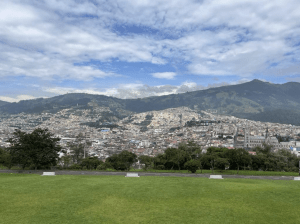Query about Quito’s Carbon Emissions
“Anybody who’s been to Ecuador wants to go back because it’s beautiful out there” – Michael Steger (American actor).
Unlike Amherst which ended its winter break in early February, my program in Ecuador began in early January, meaning I had just two weeks in between the end of my studies in Spain and when I would have to depart for South America. I arrived in Quito in the first week of January, incredibly sleep deprived and sweaty. My host family was scheduled to pick me up around 8:00 am in the morning, meaning I had approximately eight hours to kill in the airport after my red-eye flight. I passed the time by taking two couch naps and watching the sequel to “Knives Out,” which I enjoyed. I love a good murder mystery.
Approximately eight hours later, I met my host family, which consisted of a grandmother and mother whose kids were also studying abroad. We headed outside, and they had me sit in the front seat so that I would have a better view of the surrounding landscape as we drove into the city. Immediately, I was taken aback. Everything was so green! Trees growing along the road were vibrant shades of green and yellow. I could see a number of different flowers and birds. Back in the States, January was a time of barren trees, dead leaves, and seasonal depression. Here, it seemed like it was the opposite.

An image taken of the local landscape in Quito, Ecuador during the middle of January.
I asked my host mother about this, and she shared that in Ecuador—because it was right on the equator and had sunny weather year-round—the countryside always looked like that. I was excited, expecting to see some of the most beautiful landscapes of my life. However, as we began to draw closer to the city center, I started to notice a change in the surrounding area. There was more trash. Though still green, some of the plants looked less healthy. A public bus passed us by, billowing grey smoke out of its exhaust pipe. I was pretty sure that it wasn’t going to be passing any smog checks in the nearby future. I didn’t mention this stark contrast as we pulled into their driveway.
Over the next few days, I saw that despite Ecuador’s lush surroundings and pledges to protect nature, Quito definitely still struggled with carbon-emission problems. The public buses were not the only automobiles to emit clouds of smoke like the one I had seen on the first day; all different types of cars on the road had similar clouds trailing them. In California, if you saw someone driving with a car like that, they could get in serious trouble. Here in Ecuador, nobody seemed to pay any attention. I decided to focus on air pollution as my sustainability focus while in Quito.
According to global statistics, the average person emits 2.32 tons of carbon dioxide per capita, more than both its neighboring countries, Peru and Colombia.1 However, when looking at the country’s annual emissions (41.32 million tons), its numbers are lower than both the other two, indicating that though its citizens emit more carbon dioxide, as a whole, the country releases fewer greenhouse gases than its South American neighbors.
This made sense to me. On average, Ecuador seemed like a relatively eco-friendly country, especially considering its 2008 constitutional amendment (see my previous blog post). But, I could also believe that certain individuals emitted high amounts of carbon dioxide, especially when considering their clearly lacking public transportation system. (I also noticed that there weren’t any auto shops with the classic “we do smog checks” signs in front of their windows.)
Curious about this issue, I asked one of my local friends, an Ecuadorian who was in the same marine ecology program as myself. Though he wasn’t able to speak to all of the specifics regarding carbon emissions in the city (he, himself, is from the coast), he was able to confirm my initial guess that air pollution was a huge issue for the country’s capital. He explained that there are very few smog checks and that when they do rarely occur, people will occasionally switch out parts from their own cars with those of other automobiles to ensure that they pass their inspections. Coming from the Bay Area, this shocked me.
In general, though, it does seem like the city of Quito is a relatively “green” landmark, especially in comparison to other capitals around the world. (For instance, Washington D.C. emits around 102.1 metric tons of carbon each year, which is more than twice the amount of the entire country of Ecuador.) I would be curious to study this issue further if given the opportunity. Though I was technically “living” in Quito for seven weeks, I actually only spent five there, as the other two were dedicated to academic-related excursions outside of the city.
Take into account a full academic schedule and adjusting to a new country…well, there wasn’t too much free time for investigations into the city’s carbon emissions. Hopefully, I’ll have the chance to return in the future. And, when that happens, I’ll make sure to learn more about Quito’s greatest sustainability feats and foes.
Links:
1https://ourworldindata.org/co2/country/ecuador?country=ECU~ESP~USA~COL~PER